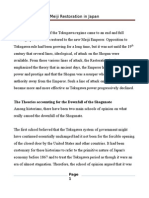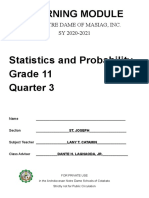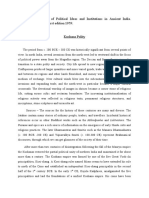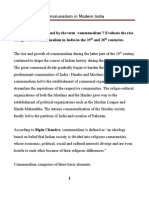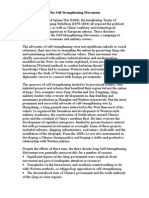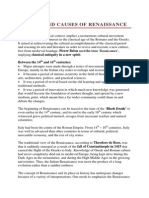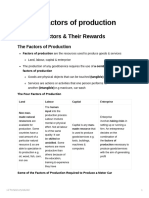Indian Feudalism
Indian Feudalism
Uploaded by
Ramita UdayashankarCopyright:
Available Formats
Indian Feudalism
Indian Feudalism
Uploaded by
Ramita UdayashankarCopyright
Available Formats
Share this document
Did you find this document useful?
Is this content inappropriate?
Copyright:
Available Formats
Indian Feudalism
Indian Feudalism
Uploaded by
Ramita UdayashankarCopyright:
Available Formats
INDIAN FEUDALISM
Discuss the historiographical debate on the question on Indian feudalism. How far was the early medieval India a time of societal changes? The early medieval period in Indian history has been described by historians a rather dark phase of Indian history characterised by political disintegration and cultural decline. The absence of political unity is the key factor that led to the emergence of rich regional cultures and the kingdoms of early medieval period. The decentralised nature of early medieval polity, according to Marxists historiography, is to be appreciated, analysed and situated in the broader context of a new type of formation in the early medieval period, viz. the emergence and crystallization of what is termed as the Indian feudalism. The early medieval state and society in north India has been explained in the context of Indian feudalism by historians like D.D. Kosambi, R.S. Sharma, D.N. Jha, B.N.S. Yadava, and various others. The period from 750 1200 in Indian history has been termed as a period of Indian feudalism by these historians. The multiplicity of regional powers and the absence of a unitary or paramount power have obliged historians to suggest a shift in the nature of polity during this period. They believed that a number of changes took place in Indian society. According to Irfan Habib, the period between the collapse of the last great North Indian empire of the 1st millennium, that of Harshavardhana (648 BC), and the beginning of the regime of the Sultans of Delhi (1206) is often designated as either late ancient or early medieval. D.D. Kosambi and R.S. Sharma have invoked a more profound basis these six centuries, namely, the dominance of Indian feudalism during this period. Kosambi was the first to provide a conceptual definition of Indian feudalism when he talked about what he described as feudalism from above and feudalism from below. Feudalism from above A state wherein the king levied tribute from subordinates who still ruled in Feudalism from below A stage where a class of landowners developed between the state and the
their own right as long as they paid. The taxes were collected directly by the royal officials.
peasantry within the village to wield armed power over the local population. Taxes were collected by small intermediaries who passed on a fraction to the feudal hierarchy.
Kosambi thought that by a process of craft diffusion among villages, there came about a breakdown of the previous dependence of the village on town and, thereby, the emergence of village isolation. This, to him, formed the bedrock of the feudal order, seen in the weakening of the centralised state and the rise of localised aristocracies. The conversion of the untouchables or outcasts into a landless working class also appears to have reached an advanced stage within the 1st millennium AD. Village self sufficiency undermined commerce; and the entire period up till about 1000 is widely seen as one of urban decline. Gold and silver money tended to contract over most of India and even disappear; and this strongly suggests a decline in the number of large commercial transactions. The most theoretical construct that contributed towards a better understanding of the early medieval period was developed by R.S. Sharma. He calls this type of agrarian setup as feudal based on the pan-Indian character of land grants. He talks about various issues like: Administrative structure based on the control and possession of land Fragmentation of political authority Hierarchy of landed intermediaries Dependence of peasants on landlords Oppression and immobility of peasants Restricted use of metal money According to him, there were a decline in trade and urbanism, paucity of coins, and increasing numbers of land grants to the state officials in lieu of salary and to the Brahmans as charity or ritual offering in the post-Gupta period. He described the period, in political terms, as one which stood witness to a continuous process of fragmentation and decentralisation, caused by the widespread practice of granting land holdings to feudatories and officials who established their control over these territories and emerged as independent potentates. Almost all features of west European feudalism, such as serfdom, manor, self-sufficient economic units, feudalisation of crafts and commerce, decline of long-distance trade and decline of towns, were said to be found in India. The most crucial aspects of Indian feudalism were the increasing dependence of the peasantry on the intermediaries who received grants of land from the state and enjoyed juridical rights over them. This development
restricted the peasants mobility and made them subject to increasingly intensive forced labour. In his article How Feudal Was Indian Feudalism? while accepting the fact that feudalism was not a universal phenomenon, he argues that this was not true of all the pre-capitalist formations. Thus tribalism, the stone age, the metal age, and the advent of a food-producing economy are universal phenomena. They do indicate some laws conditioning the process and pattern of change. According to him, there was feudalism in India, even though its nature was significantly different. Feudalism appears in a predominantly agrarian economy which is marked by a class of landlords and a class of servile peasantry. It has been seen as a mechanism for the distribution of the means of production and for the appropriation of the surplus. When Indian Feudalism appeared, early critics argued that Sharma had mechanically imported the "Europeanist" model, especially in his invocation of the role of foreign trade as an instrument of socio-economic change. The construct of Indian feudalism by R.S. Sharma drew criticism from scholars like D.C. Sircar who was of the view that a large number of grants were made to Brahmins and other religious institutions, there was scant evidence of the existence of land grants of a secular kind with service tenures. For B.N.S. Yadava, the most important feature of Indian feudalism was the samanta or the independent neighbouring chief, who rose to prominence in about 600 or so. His main intention was to reinstall feudatories and court dignitaries and to reclaim them from the oblivion that their erstwhile vanquished status had relegated them to. Harbans Mukhia questions the very possibility of the existence of Indian feudalism. He begins in his article Was there Feudalism in Indian history? by arguing that there is no single, universally accepted definition of feudalism. He actually contends that the term feudalism itself is not conducive for implementation in the context of any period in Indian history. He defines feudalism as the structured dependence of the entire peasantry on the lords. Such a system was specific to Western Europe between the 5th 15th centuries. He considers feudalism as a transitional system which stood mid-way in the transition of the West European economy from a primarily slave-based system of agricultural production to one dominated by the complementary classes of the capitalist farmers and the landless agricultural wage-earner, but in which the
free peasantry also formed a significant element. On the basis of this definition of feudalism, Mukhia now argues against the concept of feudalism in India. He is of the opinion that Indian feudalism could well have been a non-existent, make belief construct for which there was no supporting evidence. He points out that, in the European context, feudalism emerged due to changes in society, whereas in India, the establishment of feudalism has been attributed to the state practice of making land grants. He is of the view that feudalism, which is a very complex socio-political structure, could not have possibly been a state imposition, which gained more ground and later became more firmly entrenched on Indian soil through administrative and legal procedures. He expressed virulent disbelief in the existence of serfdom. He argues that it is not sure that there was a very significant decline of trade and towns in early medieval India. About the most crucial aspect of feudalism the dependence of peasantry on the landlords he thinks that there is no evidence to prove it in Indian case. He is of the view that the medieval Indian system was marked by a free peasant economy. The medieval European serfs labour for the purposes of agriculture production was set under the control of the lord, whereas the labour of his Indian counterpart was under his own control; what was subject to the states control was the amount of produce of the land in the form of revenue. He argues that even though the exploitation of the peasantry might have increased, there is no evidence to prove that there was any extraneous control over the peasants process of production. He thinks that forced labour in India remained, by and large, an incidental manifestation of the ruling class political and administrative power rather than a part of the process of production. B.D. Chattopadhyaya has questioned the theory of urban decay and the decline of trade in the post-Gupta period, a very essential premise of the feudalism argument. He agrees that the existence of land grants cannot be denied, nor can the presence of the contractual element in these land grants be negated completely. He considers land grants as an important but not the sole criteria for understanding the structure of polity. He tries to give a fresh look at the formation of polity in early medieval India and it is this that has led historians to reinterpret developments from a macro to a micro level. He talks about the emergence and gradual development of a state society. According to Harman Kulke, this process of the expansion of state society, through the transformation of pre-state polities into state polities, was based on and progressed along with certain other crucial phenomena like the emergence and expansion of ruling lineages.
The model developed by Chattopadhyaya, is called Integrative polity which linked the process of the formation of state polities with economic and social processes. He has successfully been able to link the expansion of agrarian society through the peasantisation of tribal groups. The integrative polity sees political processes in the context of contemporary economic, social and religious developments, such as the horizontal spread of the dominant ideology of the social order based on the Varna division, integration of local cults, rituals and sacred centres/places into a larger structure. Chattopadhyaya also highlights the formation of ruling lineages from the perspective of the process of social mobility in early medieval India. He explains that through Kshatriyaisation, any lineage or segment of a large ethnic group could make an attempt to assume political power and establish a large state structure by an effective mobilisation of force. Salient features of Indian feudalism according to R.S. Sharma: Emergence of hierarchical landed intermediaries. Vassals and officers of state and other secular assignees had military obligations and were called Samanta. Sub-infeudation by these donees to get their land cultivated led to the growth of different strata of intermediaries. It was a hierarchy of landed aristocrats, tenants, share- croppers and cultivators. This hierarchy was also reflected in the powers, administrative structure, where a sort of lord-vassal relationship emerged. In other words, Indian feudalism consisted of the gross unequal distribution of land and its produce. Prevalence of forced labour. The right of extracting forced labour is believed to have been exercised by the Brahmanas and other grantees of land. Forced labour was originally a prerogative of the king or the state. It was transferred to the grantees, petty officials, village authorities and others. As a result, a kind of serfdom emerged, in which agricultural labourers were reduced to the position of semi-serfs. Due to the growing Claims of greater rights over them by rulers and intermediaries, peasants also suffered a curtailment of their land rights. Many were reduced to the position of tenants facing ever-growing threat of eviction. A number of peasants were only share-croppers (ardhikas). The strain on the peasantry was also caused by the burden of taxation, coercion and increase in their indebtness. Surplus was extracted through various methods. Extra economic coercion was a conspicuous method, new mechanisms of economic subordination also evolved.
It was relatively a closed village economy. The transfer of human resources along with land to the beneficiaries shows that in such villages the peasants, craftsmen and artisans were attached to the villages and, hence, were mutually dependent. Their attachment to land and to service grants ensured control over them by the beneficiaries. Sharma had also placed much emphasis upon the absence of long distance external trade as the cause of the rise of feudalism in India. But trade had flourished in several regions of India long before the feudalism proponents set a deadline for its revival around the year AD 1000 BD. The most crucial aspects of Indian feudalism were the increasing dependence of the peasantry on the intermediaries who received grants of land from the state and enjoyed juridical rights over them. This development restricted the peasants mobility and made them subject to increasingly intensive forced labour.
CONCLUSION
According to Sharma, feudal polity emerged from the gradual breakdown of a centralised bureaucratic state system, the best example of which was the Mauryan state. The system of assigning land gradually became widespread in the early medieval period and was tied up with the transfer of the rights of administration of the centralised state as well as its rights over sources of revenue. This process gradually eroded the authority of the state and resulted in a weakened sense of sovereignty. According to H. Mukhia, the primarily free peasant form of agricultural production gradually evolving from post-Maurya times, thus characterized the agrarian economy of ancient and medieval India. In such a scenario there was no possibility of a feudal system of production in India. Sharma further argues that, contrary to Mukhias arguments, forced labour was also prevalent in many parts of the country. On the basis of various evidences, he asserts that there was feudalism during the early medieval period in India which was characterized by a class of landlords and by a class of subject peasantry, the two living in a predominantly agrarian economy marked by decline of trade and urbanism and by drastic reduction in metal currency. Thus, the stereotypical construct of Indian feudalism has been subjected to a radical reappraisal. The integratrative polity model has gained much popularity
in recent years because it tries to accommodate the long term dynamics of change in Indian history. Revival of long- distance trade, rise of towns, and flight of peasants and development of monetary economy were considered to be the main processes responsible for the decline of feudalism in India. In this schema, the process of feudalisation started sometimes in the 4th century and declined in the 12th century.
BIBLIOGRAPHY
Medieval India: The study of a Civilization Irfan Habib Early Medieval Indian society R. S. Sharma Interpreting Early Medieval India Vipul Singh Was there Feudalism in Indian history? - Harbans Mukhia How feudal was Indian feudalism? - R.S. Sharma
You might also like
- T. H. Marshall's Theory of CitizenshipDocument6 pagesT. H. Marshall's Theory of CitizenshipRamita Udayashankar100% (5)
- Feudalism Debate in IndiaDocument9 pagesFeudalism Debate in Indiagulrez ansari70% (10)
- Was There Feudalism in Indian History? - Harbans MukhiaDocument2 pagesWas There Feudalism in Indian History? - Harbans MukhiaRamita Udayashankar100% (8)
- DU Answer On Premakhyan HOI4Document4 pagesDU Answer On Premakhyan HOI4Arham Khan60% (5)
- Meiji Restoration in JapanDocument21 pagesMeiji Restoration in JapanRamita Udayashankar100% (5)
- Crisis of Tokugawa Regime in JapanDocument13 pagesCrisis of Tokugawa Regime in JapanRamita Udayashankar100% (5)
- Statistics and Probability Learning Module 3rd QuarterDocument69 pagesStatistics and Probability Learning Module 3rd QuarterLANY T. CATAMIN100% (1)
- Debate On Indian FeudalismDocument19 pagesDebate On Indian FeudalismGourav Shaw50% (2)
- Indian Feudalism DebateDocument16 pagesIndian Feudalism DebateJintu ThresiaNo ratings yet
- Nature of Chola State - Docx PresentationDocument8 pagesNature of Chola State - Docx Presentationpriyanka100% (8)
- Nature of State of Early Medieval India PDFDocument7 pagesNature of State of Early Medieval India PDFNitu KundraNo ratings yet
- Indian Feudalism Debate AutosavedDocument26 pagesIndian Feudalism Debate AutosavedRajiv Shambhu100% (1)
- Cholas - Theory On Nature of StateDocument8 pagesCholas - Theory On Nature of StateKundan100% (1)
- Medieval India Agrarain ExpansionDocument6 pagesMedieval India Agrarain ExpansionHimanshu Thakuria100% (28)
- Nature of The Chola State PDFDocument4 pagesNature of The Chola State PDFNainaNo ratings yet
- Origin of RajputsDocument11 pagesOrigin of Rajputskulbhushan100% (2)
- Origin of RajputsDocument7 pagesOrigin of RajputsLettisha Liju50% (2)
- Kushana PolityDocument5 pagesKushana PolityKunal100% (1)
- Medieval India History Reconstructing ResoourcesDocument9 pagesMedieval India History Reconstructing ResoourcesJoin Mohd ArbaazNo ratings yet
- Rise of Rajputs and The Nature of StateDocument3 pagesRise of Rajputs and The Nature of StateSanchari DasNo ratings yet
- Inter-Regional and Maritime TradeDocument24 pagesInter-Regional and Maritime TradeNIRAKAR PATRA100% (2)
- First United FrontDocument12 pagesFirst United FrontRamita Udayashankar100% (2)
- Rajput KingdomDocument4 pagesRajput KingdomRamita Udayashankar88% (8)
- 2 - Integration of Indigenous GroupsDocument7 pages2 - Integration of Indigenous GroupsUtsav KumarNo ratings yet
- Persian Sources For Reconstructing History of Delhi SultanateDocument6 pagesPersian Sources For Reconstructing History of Delhi SultanateKundanNo ratings yet
- Nationalism and Social Group Interfaces PDFDocument93 pagesNationalism and Social Group Interfaces PDFdeeksha verma86% (7)
- Economic History of Early Medieval IndiaDocument52 pagesEconomic History of Early Medieval IndiaALI100% (3)
- (A) Agricultural Production in Mughal India: Unit 3: Rural Economy and SocietyDocument17 pages(A) Agricultural Production in Mughal India: Unit 3: Rural Economy and Societyila100% (1)
- History of India IV: Assignment: - Submitted by Sasanbha Lytan, 2 Year, B.A. History (Hons)Document8 pagesHistory of India IV: Assignment: - Submitted by Sasanbha Lytan, 2 Year, B.A. History (Hons)shabdita50% (2)
- Iqta System During Sultanate PeriodDocument4 pagesIqta System During Sultanate Periodayush100% (2)
- Sources of Early MedievalDocument11 pagesSources of Early MedievalAanchal ShawNo ratings yet
- VijaynagarDocument15 pagesVijaynagarsmrithi100% (1)
- Agricultural Production in 13th and 14th CenturiesDocument5 pagesAgricultural Production in 13th and 14th CenturiessmrithiNo ratings yet
- Transition in Elite Composition During The Delhi SultanateDocument10 pagesTransition in Elite Composition During The Delhi SultanateSania Mariam100% (9)
- A Study of Sources of The Sultanate With Emphasis On The Malfuzat and The Premakhyan TraditionDocument8 pagesA Study of Sources of The Sultanate With Emphasis On The Malfuzat and The Premakhyan TraditionIt's vibpathak100% (1)
- 18th Century As A Period of TransitionDocument5 pages18th Century As A Period of TransitionAshwini Rai0% (1)
- Archaeological Sources of The Delhi Sultanate - Aneesh Raj - SM0120071Document7 pagesArchaeological Sources of The Delhi Sultanate - Aneesh Raj - SM0120071Aneesh Sharma100% (1)
- Colonial IdeologiesDocument9 pagesColonial IdeologiesHarshita Saxena100% (1)
- Trade in Early Medieval IndiaDocument3 pagesTrade in Early Medieval IndiaAshim Sarkar100% (1)
- Market Policy of Allauddin KhiljiDocument5 pagesMarket Policy of Allauddin KhiljiPriyam MishraNo ratings yet
- Debates Over 18th Century India Change V PDFDocument6 pagesDebates Over 18th Century India Change V PDFAbhishek Shivhare100% (1)
- Changing Relations With Nobility in Delhi SultanateDocument7 pagesChanging Relations With Nobility in Delhi SultanateAmala Anna Anil100% (2)
- MHI 06 Assignment IGNOUDocument6 pagesMHI 06 Assignment IGNOUAPA SKG100% (3)
- Mughal Theory of KingshipDocument11 pagesMughal Theory of Kingshipwww.tultulboruah12345No ratings yet
- Post-Mauryan EconomyDocument6 pagesPost-Mauryan EconomyRamita Udayashankar100% (3)
- 1.2 The Eighteenth Century Society Economy and PolityDocument28 pages1.2 The Eighteenth Century Society Economy and PolitySania Mariam100% (1)
- Vijayanagara Empire AdministrationDocument17 pagesVijayanagara Empire AdministrationAndroid app developer50% (2)
- Temples in Early Medieval IndiaDocument5 pagesTemples in Early Medieval IndiaRamita Udayashankar100% (3)
- Women and Power (Raziyya and Rudramadevi)Document8 pagesWomen and Power (Raziyya and Rudramadevi)Niranjan BhuyanNo ratings yet
- History Notes by e Tutoriar PDFDocument53 pagesHistory Notes by e Tutoriar PDFRohan GusainNo ratings yet
- English Revolution and Various InterpretationsDocument8 pagesEnglish Revolution and Various Interpretationsayush100% (1)
- History Sem. 2 Project - Mughal Land Revenue SystemDocument14 pagesHistory Sem. 2 Project - Mughal Land Revenue Systemankit_chowdhri100% (11)
- Akbar's Religious PolicyDocument7 pagesAkbar's Religious Policyhcctygy979No ratings yet
- Debate of Deindustrialisation 1860-1880Document8 pagesDebate of Deindustrialisation 1860-1880Ankit100% (1)
- Tarikh-i-Firoz ShahiDocument6 pagesTarikh-i-Firoz ShahiMandeep Kaur PuriNo ratings yet
- Origins of The Vijayanagar StateDocument12 pagesOrigins of The Vijayanagar StateJugger nautNo ratings yet
- Jagirdari N CrisisDocument10 pagesJagirdari N CrisisRichard KeifthNo ratings yet
- Mughal Rajput RelationsDocument18 pagesMughal Rajput RelationsVijay Shree100% (1)
- Vedic AgeDocument8 pagesVedic AgeRamita Udayashankar100% (2)
- Discuss The Emergence and Role of Women Saints in Medieval Indian SocietyDocument10 pagesDiscuss The Emergence and Role of Women Saints in Medieval Indian SocietySania Mariam100% (7)
- Nayankara System in VijayanagaraDocument11 pagesNayankara System in Vijayanagararicha ayengiaNo ratings yet
- Feudalism in IndiadocxDocument5 pagesFeudalism in IndiadocxTaha HassanNo ratings yet
- Feudalism and The Eco, Soc and Pol Changes.Document7 pagesFeudalism and The Eco, Soc and Pol Changes.raisha.galib2014No ratings yet
- Class 12th History - Kinship Caste and ClassDocument47 pagesClass 12th History - Kinship Caste and ClassRamita Udayashankar100% (1)
- Communalism in Modern IndiaDocument12 pagesCommunalism in Modern IndiaRamita Udayashankar100% (3)
- Plantation Economy and Slavery in AmericaDocument14 pagesPlantation Economy and Slavery in AmericaRamita Udayashankar100% (1)
- Military Modernization of JapanDocument10 pagesMilitary Modernization of JapanRamita UdayashankarNo ratings yet
- Revolt of 1857 - CausesDocument3 pagesRevolt of 1857 - CausesRamita Udayashankar100% (4)
- First United FrontDocument12 pagesFirst United FrontRamita Udayashankar100% (2)
- Economic Modernization of Meiji JapanDocument15 pagesEconomic Modernization of Meiji JapanRamita Udayashankar100% (1)
- Marxist Theory of Citizenship - Anthony GiddensDocument4 pagesMarxist Theory of Citizenship - Anthony GiddensRamita UdayashankarNo ratings yet
- Political Modernization of Meiji JapanDocument18 pagesPolitical Modernization of Meiji JapanRamita UdayashankarNo ratings yet
- GlobalizationDocument19 pagesGlobalizationRamita Udayashankar90% (10)
- The Hundred Day Reform, 1898Document8 pagesThe Hundred Day Reform, 1898Ramita Udayashankar75% (4)
- The Taiping Rebellion/Uprising in ChinaDocument5 pagesThe Taiping Rebellion/Uprising in ChinaRamita Udayashankar60% (5)
- 18th Century Debate in IndiaDocument3 pages18th Century Debate in IndiaRamita Udayashankar94% (67)
- The Self Strengthening MovementDocument2 pagesThe Self Strengthening MovementRamita Udayashankar33% (3)
- Educational Modernization of JapanDocument12 pagesEducational Modernization of JapanRamita UdayashankarNo ratings yet
- Boxer Uprising/Rebellion in ChinaDocument5 pagesBoxer Uprising/Rebellion in ChinaRamita Udayashankar100% (2)
- Revolt of 1857 - Nature/HistoriographyDocument3 pagesRevolt of 1857 - Nature/HistoriographyRamita Udayashankar90% (10)
- The May Fourth Intellectual Revolution, 1917-1923Document5 pagesThe May Fourth Intellectual Revolution, 1917-1923Ramita Udayashankar100% (4)
- Presidential and Radical ReconstructionDocument4 pagesPresidential and Radical ReconstructionRamita Udayashankar100% (1)
- Revolt of 1857 - ConsequencesDocument1 pageRevolt of 1857 - ConsequencesRamita UdayashankarNo ratings yet
- Opium Wars in ChinaDocument4 pagesOpium Wars in ChinaRamita Udayashankar67% (3)
- American Revolution: Discuss The Causes, Nature, and Significance of The American RevolutionDocument4 pagesAmerican Revolution: Discuss The Causes, Nature, and Significance of The American RevolutionRamita Udayashankar100% (4)
- Transition From Feudalism To CapitalismDocument8 pagesTransition From Feudalism To CapitalismRamita Udayashankar91% (34)
- Spanish Colonization by The European PowersDocument3 pagesSpanish Colonization by The European PowersRamita Udayashankar100% (1)
- Turkish Invasion in IndiaDocument2 pagesTurkish Invasion in IndiaRamita Udayashankar91% (11)
- Bhakti MovementDocument4 pagesBhakti MovementRamita Udayashankar100% (5)
- Origin and Causes of RenaissanceDocument2 pagesOrigin and Causes of RenaissanceRamita Udayashankar100% (4)
- Ram Puppala - PayslipDocument1 pageRam Puppala - PaysliponechancedotcomNo ratings yet
- Stenner Pump Company: CatalogDocument56 pagesStenner Pump Company: CatalogLMOVIEDONo ratings yet
- Exchange Rates Volatility and Economic GrowthDocument23 pagesExchange Rates Volatility and Economic GrowthCaroline MichaelNo ratings yet
- IGCSE Economics 1.2 The Factors of ProductionDocument4 pagesIGCSE Economics 1.2 The Factors of Productionyeweiwei0925No ratings yet
- 2022 KALN Youpai Series Mesh Chairs Quotation SheetDocument42 pages2022 KALN Youpai Series Mesh Chairs Quotation SheetAngel RomeroNo ratings yet
- Variance AnalysisDocument55 pagesVariance AnalysisAbhishek JhaNo ratings yet
- Managerial Ecnomics Subject Outline - StudentversionDocument10 pagesManagerial Ecnomics Subject Outline - StudentversionAhmed MunawarNo ratings yet
- Philippine Christian University: Understanding Culture, Society, and Politics (G 12) W 9 MAY 4-8, 2020Document7 pagesPhilippine Christian University: Understanding Culture, Society, and Politics (G 12) W 9 MAY 4-8, 2020Adrian DoblasNo ratings yet
- Uts Comprehensive Case PT WikaDocument7 pagesUts Comprehensive Case PT WikaFerial FerniawanNo ratings yet
- Bid DocumentDocument17 pagesBid DocumentRAJENDRA METALSNo ratings yet
- Momo Domo b2b PDFDocument3 pagesMomo Domo b2b PDFsrikanth829No ratings yet
- Seasonal Models Forecasting Practice Problems Oct 2015Document4 pagesSeasonal Models Forecasting Practice Problems Oct 2015VIshakNo ratings yet
- ABM 311 (Introductory Microeconomic Theory) 1. Module 3 Consumer Choice and Demand: The Indifference Curve ApproachDocument5 pagesABM 311 (Introductory Microeconomic Theory) 1. Module 3 Consumer Choice and Demand: The Indifference Curve ApproachIrene PacunayenNo ratings yet
- STR 1Document1 pageSTR 1Christian BenitezNo ratings yet
- Maskara Enterprises: Purchase OrderDocument1 pageMaskara Enterprises: Purchase OrderVidhi MaskaraNo ratings yet
- Account Number Customer Id Account Currency Opening Balance Closing BalanceDocument4 pagesAccount Number Customer Id Account Currency Opening Balance Closing Balancesamaa adelNo ratings yet
- Fee Structure 2024 25 For CBSEDocument2 pagesFee Structure 2024 25 For CBSEsoulking6909No ratings yet
- Ground Rent Charges - Zambia Municipal CouncilDocument7 pagesGround Rent Charges - Zambia Municipal CouncilBrian ManyauNo ratings yet
- Chapter 1-Practice - SolutionDocument18 pagesChapter 1-Practice - SolutionXpertZ Pro 1No ratings yet
- Accutech - General Catalog DTD 030717Document4 pagesAccutech - General Catalog DTD 030717Em JoeNo ratings yet
- Buy Croma 6.5 KG Semi Automatic Top Loading Washing Machine (CRAW2221, White) Online - CromaDocument1 pageBuy Croma 6.5 KG Semi Automatic Top Loading Washing Machine (CRAW2221, White) Online - Cromahimanshudahiya87No ratings yet
- Modul BI Composition PMR 3Document14 pagesModul BI Composition PMR 3Fauzee AzerbaijanNo ratings yet
- Business-Plan-ment-Based-BlocketDocument45 pagesBusiness-Plan-ment-Based-BlocketJemal100% (2)
- Chapter 8: Costs and Revenues: Andrew GillespieDocument19 pagesChapter 8: Costs and Revenues: Andrew GillespiemuthurajNo ratings yet
- Week No 40,43 GR, 3 Day'sDocument1 pageWeek No 40,43 GR, 3 Day'sshinde rushiNo ratings yet
- Add: Desired Ending Raw Materials Inventory (130% From Following Month's Production and 2000Document4 pagesAdd: Desired Ending Raw Materials Inventory (130% From Following Month's Production and 2000Kyla Kim AriasNo ratings yet
- Singur MovementDocument12 pagesSingur MovementPrasun SadhukhanNo ratings yet
- Nozzle M - Spray SystemDocument4 pagesNozzle M - Spray SystemAry SetiawanNo ratings yet
- Group # Name:: 3 Lucy VanDocument16 pagesGroup # Name:: 3 Lucy VanNgoc Tram VanNo ratings yet





